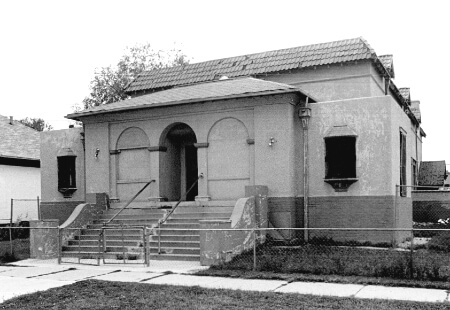A grassroots effort to create an official historic district on Denver’s West Side, where much of the Denver Jewish community began, will enter a crucial phase on Wednesday, Nov. 9, with the first of a series of public meetings to discuss the potential impact of the district on those who live there today.

The Labor Lyceum, later home of Zera Abraham, pictured in the 1980s. (Bob Weinberg)
A citizens committee advocating the creation of the West Colfax Jewish Historic Cultural District will host the forum at the VFW lodge at 4747 W. Colfax Ave. at 5:30 p.m.
The history of the area as a seminal home for Denver Jewry will be discussed, as will locations of historic significance and how the creation of a historic district may affect such topics as neighborhood property values and home renovations.
“We want to get a feel for how the neighborhood feels about having a historic district,” resident Pam Smith told the Intermountain Jewish News recently.
Smith describes herself as “the connector, the person who makes phone calls and sets up meetings” for the committee, which includes a handful of current Jewish West Siders, City Councilwomen Amanda Sandoval and Jamie Torres, Historic Denver, the Denver Landmark Commission and Rabbi Mordechai Fleisher of Cong. Zera Abraham, the sole remaining synagogue in the neighborhood.
“We’re going to have a series of meetings, every month for a year, to help people understand the nature of a historic district and how it will affect them and their homes,” Smith added.
“We’ll give them lots of time to share their thoughts and concerns about their home values and other issues. Answers will be coming from the staff of the Denver Landmark Commission as well.”
A film narrated by Dr. Jeanne Abrams of the Rocky Mountain Jewish Historical Society will be shown at the Nov. 9 forum.
The campaign to create the district began some five years ago, Smith says, and has since raised some $20,000 from Historic Denver, the City and County of Denver and the Rose Community Foundation to prepare for the current public discussion phase.
Most of those funds have gone to pay for an initial nomination proposal by Fort Collins-based Tatanka Historical Associates, whose president Ron Sladek wrote, “the preparation of a landmark nomination for an urban district is a complicated undertaking that involves field documentation, archival research, contextual development, architectural evaluation and the analysis of historic sites, buildings, structures, and objects.”
The proposal describes how the district would encompass three geographical areas on the West Side, ranging from Sheridan Blvd. on the west to east of Federal Blvd.
The western sections straddle the north and south corridors along West Colfax.
The eastern section, south of Colfax, includes areas close to today’s Empower Field at Mile High, home field of the Denver Broncos.
The eastern section represents one of the earliest Jewish neighborhoods in Denver where, in the latter half of the 19th century, many Eastern European Jews settled, forming synagogues and businesses in an area often referred to as “Under the Viaduct.”
Few physical structures representing that neighborhood still stand today. The very small and typical home in which the late IJN publisher Max Goldberg grew up on Paul Court is now the site of a water facility.
The western sections represent areas to which Jews migrated in latter decades, establishing a close-knit community that ranged from haredi to modern Orthodox to secular, with a strong Yiddish cultural character.
Any number of structures hailing from this neighborhood remain standing today, although some of them no longer have Jewish connections.
The Tatanka proposal lists a total of 21 West Side structures to consider for landmark designation in the proposed district, including:
- Tobin Pharmacy
- Lake Steam Baths
- Beth Israel Old Folks Home
- the Labor Lyceum
- Beth Jacob High School
- Cong. Zera Abraham
- Yeshiva Toras Chaim (whose facility is on the site of the former home of the Hebrew Educational Alliance)
- the original HEA structure on the south side of Colfax
- former Zera Israel and Yad Achas synagogues
- Two surviving structures from the “Under the Viaduct” neighborhood: Pellish Theater and the J. Solf Bldg.
The district proposal calls for the collection of anecdotal and historic information from former and current residents of the West Side, Smith says. The committee hopes to gather such information from the public meetings and other forms of outreach. The committee plans to reach out to synagogues and Jewish institutions on Denver’s East Side in its search for historical information from former West Siders and their descendants.
“The most exciting part of this for me,” Smith says, “is that we are hoping not only to preserve the buildings but also the stories of the West Side.”
While what remains of the West Side Jewish community today is its Orthodox Jewish community, the committee welcomes participation from all streams of Judaism in its effort to preserve the neighborhood’s Jewish history.
“We would like to have as many people as possible to connect all these stories together and preserve the history of the neighborhood,” Smith says.
After a year of monthly meetings, surveys will be provided to current residents of the proposed district to determine whether they are in favor of the plan.
If 60% approve, the proposal will go before the Denver Landmark Commission before being submitted to City Council for a final determination.
Information on the Nov. 9 meeting is available from Pam Smith, 520-906-2105.
Chris Leppek may be reached at [email protected]
Copyright © 2022 by the Intermountain Jewish News
















